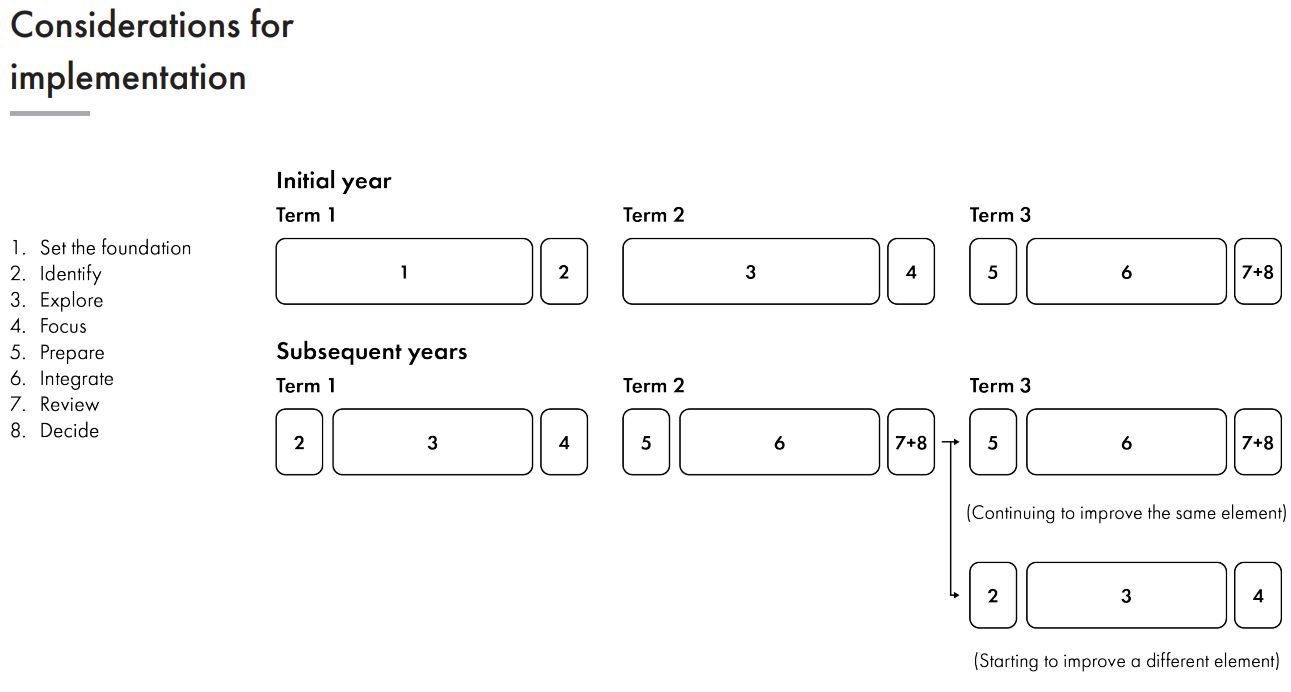There are many components of the Great Teaching Toolkit and we do not prescribe an exact model for implementing it. How your school or college will use the Toolkit depends on your context. It is your choice. Nevertheless, as a starting point, you can use the following implementation steps as a guide to develop your own approach.
Implementing the Great Teaching Toolkit for classroom teachers:
- Set the foundation. In the first term of your first year using the Toolkit, teachers complete the Foundation course. It serves as an orientation and covers core concepts at the heart of the Model for Great Teaching.
- Identify an Element of Great Teaching you want to work on. To inform this decision, you might first create a profile using the student surveys or video observation tools. This will provide insights into what teachers are already great at, and what could be an area to focus on making even better.
- Explore the research evidence behind this Element (e.g., structuring) to enhance your understanding of underlying principles, associated classroom strategies and how to select and adapt them to your context. Do this by taking a relevant Toolkit course, or by selecting your own learning – for example, this could be a relevant book, working closely with a colleague, or a combination of things.
- Focus on a particular challenge in your classroom that you wish to address – again, you might use feedback on your practice to help you decide.
- Prepare a plan to help improve in this area of focus by selecting and adapting a classroom-based strategy.
- Integrate the strategy into your teaching practice. To support you in doing this, you’ll use weekly or fortnightly cycles of planning, implementation and evaluation to hone the strategy.
- Review the impact the strategy has had in your classroom. You might update your profile by doing another student survey to help with this.
- Decide on the basis of the feedback what Element to work on next.

The implementation steps outlined above could be thought of as the examples of how an individual might work with the Toolkit. There are other approaches that are equally as valid:
- If a school or college has already identified staff development priorities, they may decide to start exploring the Toolkit courses without using the survey instruments to gain feedback. Of course, they may choose to use those tools later. In this case, all staff should still carry out the Foundation Course, prior to any other courses or programmes.
- A school or college may identify a priority area for all staff (e.g., creating a supportive environment, or behaviour and culture). In this case, they may decide that all teachers and all leaders complete the relevant course or programme as their starting point.
- Guided either by profiles from the student surveys, or by other means of prioritisation, staff groups could be created for teachers working on the same development area and goals. This creates communities of practice in different Elements of the Model for Great Teaching, with a common language around great teaching.
Implementing the Great Teaching Toolkit for middle and senior leaders:
- Set the foundation. In the first term of your first year using the Toolkit, leaders should complete the Foundation course. It serves as an orientation and covers core concepts at the heart of the Model for Great Teaching.
- Lead Programme:
a. Term 1: Developing an evidence base; building specialist knowledge and mental models based on the best available research evidence.
b. Term 2: Evidence implementation; exploring possible applications of the research evidence in school contexts.
c. Term 3: Implementation; planning; collaborating with colleagues to identify specific areas for improvement and to learn about potential contextual challenges to successful implementation; developing strategies to overcome these barriers. - Draw the pieces together to implement a cohesive department/school/college plan.
Alongside this learning, a leader may be responsible for supporting a working group of teachers, or for mentoring one or two individual staff members in their professional development where appropriate.
Implementation is a key aspect of improvement in anything – professional development and school improvement are no exceptions. The process of improvement is incremental, and the Great Teaching Toolkit is a long-term route to improvement in the quality of teaching.
If you would like to speak to one of our team about how you might implement the Toolkit in your context, you can book a call with us here!





